A journey of sustainability, enhanced experience and eco-tourism at Bangalore International Airport
- Like
- Digg
- Del
- Tumblr
- VKontakte
- Buffer
- Love This
- Odnoklassniki
- Meneame
- Blogger
- Amazon
- Yahoo Mail
- Gmail
- AOL
- Newsvine
- HackerNews
- Evernote
- MySpace
- Mail.ru
- Viadeo
- Line
- Comments
- Yummly
- SMS
- Viber
- Telegram
- Subscribe
- Skype
- Facebook Messenger
- Kakao
- LiveJournal
- Yammer
- Edgar
- Fintel
- Mix
- Instapaper
- Copy Link
Posted: 19 April 2024 | Prasannamurti Desai | No comments yet
For International Airport Review’s Issue 4, Desai Prasannamurti, the Vice President of Landscape for Bangalore International Airport, wrote exclusively about Terminal 2’s biodiversity and how it’s furthering the airport’s pledge to sustainability.
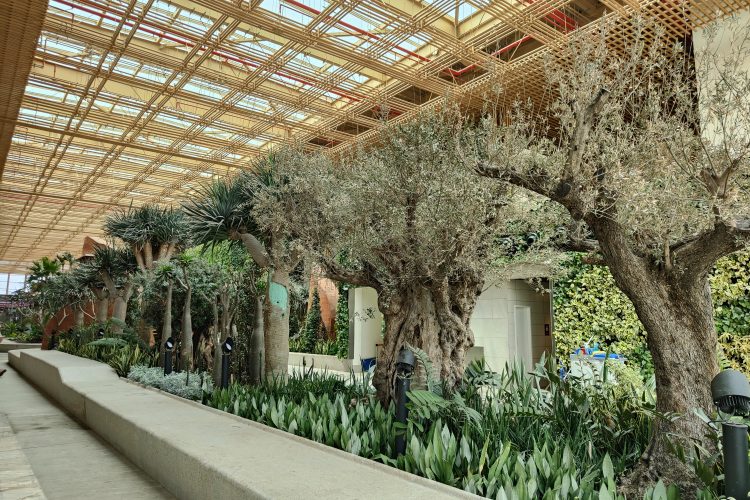

T2 redevelopment. CREDIT: Kempegowda International Airport Bengaluru
Bangalore International Airport (BLR) has always been known for its beautiful landscape and well-manicured, maintained greenery. Accepting the responsibility to drive the elevation of this airport in 2018 was nothing short of a dream for me.
Terminal 2 (T2) of BLR is the newest addition to the airport and highlights the rich history and culture of the Indian state, Karnataka.
The terminal will be constructed in two phases, with the first phase covering an area of 255,645 square metres and accommodating up to 25 million passengers annually. The second phase, which is still in the planning stage, is expected to handle an additional 20 million passengers per annum.
Creating a biodiversity hotspot
It was clear maturity of thought to progress T2 from being a ‘terminal garden’ pre-COVID-19 to a ‘biodiversity hotspot terminal’, post-COVID-19.
passengers will experience greenery like never before”
The design and details are by world-renowned architects, SOM and Grant Associates. The design had its own challenges and difficulties such as creating 14 meter-tall built-up mounds, which resemble surrounding mountains and therefore the landscape of rural Bengaluru.
T2 provides the opportunity to be a safe haven to a large number of Indian flora, as well as global tropical and sub-tropical plants, which will be conserved for generations to come.
It all started with the idea of saving topsoil – a priceless element that cannot be recreated in labs. The entire top six to eight inch soil was taken up and carefully stored. In reusing it, we ensured that we can reintroduce microbes to sustain the landscape above.
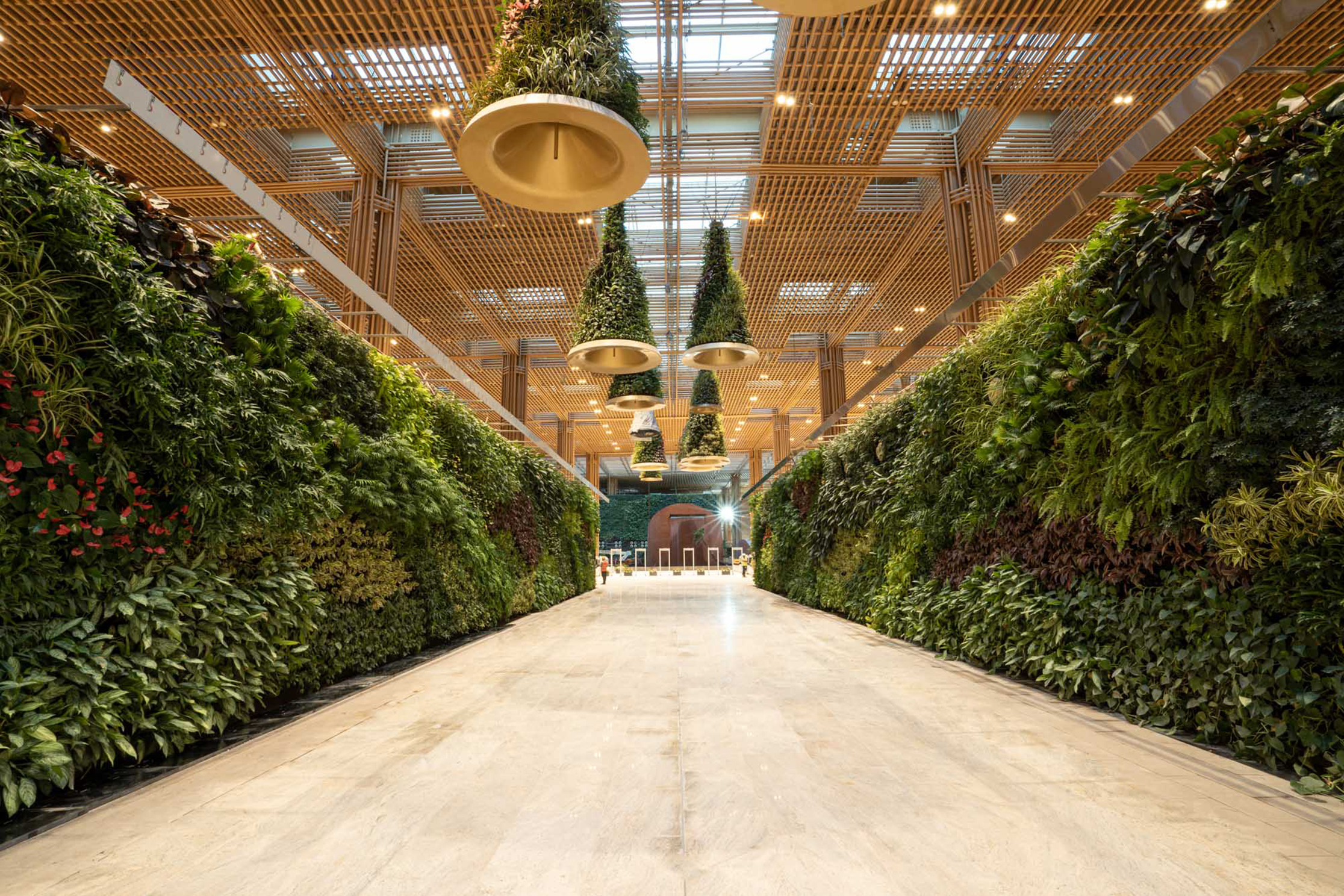

T2 redevelopment. CREDIT: Kempegowda International Airport Bengaluru
It was intended to be reforested to help reintroduce flora and for large, planted trees (that would otherwise not be in regular upkeep).
This is India’s largest transplanting and storing project and BIAL will be transplanting and storing nearly 7,900 trees and palms (some of which are 20-50+ years old ). There are also over 100,000 shrubs that have been transplanted with the utmost precision. The success of survival rates was surprising.
Forest belt
The forest belt encompasses the terminal and boarding piers and holds around 2,000+ species of Indian origin flora, trees and plants. The belt is about four acres and is made up of 90% compacted man-made forest around 10m tall. International passengers now have a unique forest canopy walk, after the completion of the walk bridge.
One of the unique features of Bangalore International Airport is its biodiversity, hosting 600-800 year-old trees and over 180 rare, endangered and threatened species. As well as this, there are about 1,200 trees species that are a part of the terminal’s ecosystem.
Unique indoor aesthetic
Additionally, the terminal has over 923km of bamboo cladding, adding to its garden-like environment and new colour appeal experimentation. Rubbing shoulders with all this greenery and technology is the T2 Art Programme, which has been inspired by Bharata’s Navarasa (as mentioned in the Natyashastra). To begin with, T2 will feature 60 artworks by 43 artists from across Karnataka and other states. We will also run ongoing initiatives to showcase the cultural diversity and art forms of southern India.
With hanging gardens and eye-catching structures, T2 is an epitome of modern sustainable infrastructure that is rooted in local culture. Hanging from the ceiling are two types of decorative planters — some which are designed in the shape of bells and others as a chain of onion baskets hanging above one another, called veils. Overall, there are 500 such systems, each holding hundreds of plants. From the ceiling alone, there are 150,000 live plants of various species.
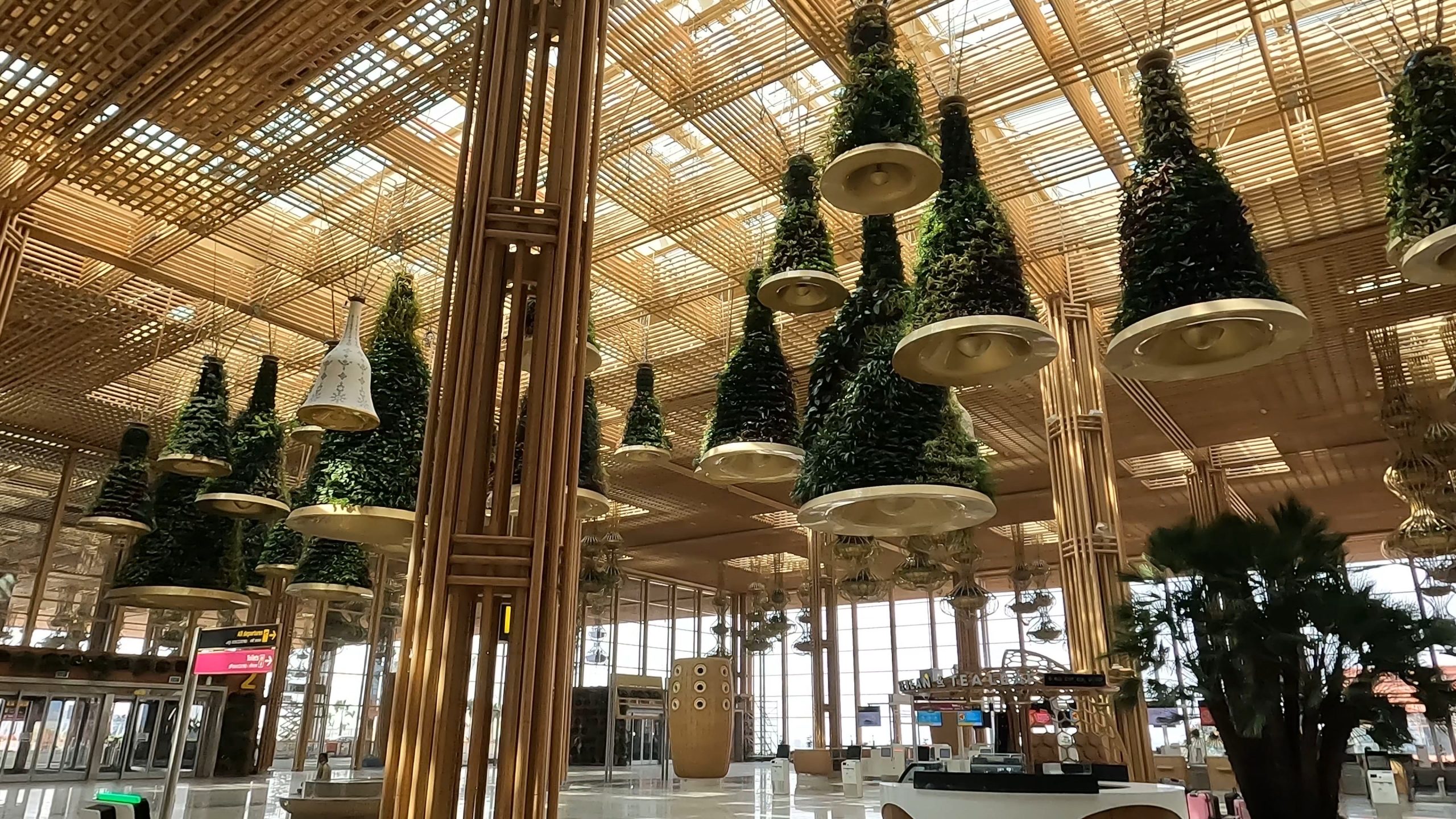

CREDIT: Kempegowda International Airport Bengaluru
In addition, about 450,000 live plants grow in green walls that line the corridor between check-in counters and security gates. In total, there are a total of 600,000 live plants in the terminal building, which passengers can explore as a garden as they walk through the terminal.
BLR has been designed to offer passengers an immersive experience to explore unique flora sourced from multiple ecological habitats in India. From the moment they enter the BLR campus from the main access road, to entering T2 and then boarding aircraft at the piers, passengers will be visually treated to every shade of green.
With 10,235sqm of green walls around the terminal; hanging gardens that cascade from the terminal roof on bronze veils; bells suspended from the ceiling; green lagoons and the extensive forest belt area between the terminal and boarding piers, passengers will experience greenery like never before. As a potential biodiversity hotspot, a total of 620 endemic plants; 3,600+ plant species; 150 palm species; 7,700 transplanted trees; 200 varieties of lilies; 96 lotus species; 180 rare, endangered, and threatened species and 10 ecological habitats make up the lush green landscape around T2.
Climate-smart water use
Bangalore International Airport is the first airport in India to adopt a weather-based smart irrigation system for a complete landscape area both inside and outside the terminal. It has sensor-based Internet of Things (IoT) systems for the unique hanging gardens.
The climate-smart micro-irrigation system is completely automated, runs on weather stations which record five parameters and provides the daily evapotranspiration per zone, to set the irrigation cycle. Every drop is utilised efficiently. Root zone irrigators and clever use of inline drip tubes discharge water at a rate of 1-2.3 litres per hour and at a spacing of 40cm distance. Efficient use of soil moisture sensor, water level sensors and rain sensors help utilise water efficiently.
Forest of Abundance
There is also an on-site rare plant museum which gives information about the plants from historical texts, that are over 7,000 years old. Trees which are held as sacred and are known for being a source of oxygen/nourishment, are being planted across an area of 20 acres. This is also known as a Forest of Abundance, or FOA.
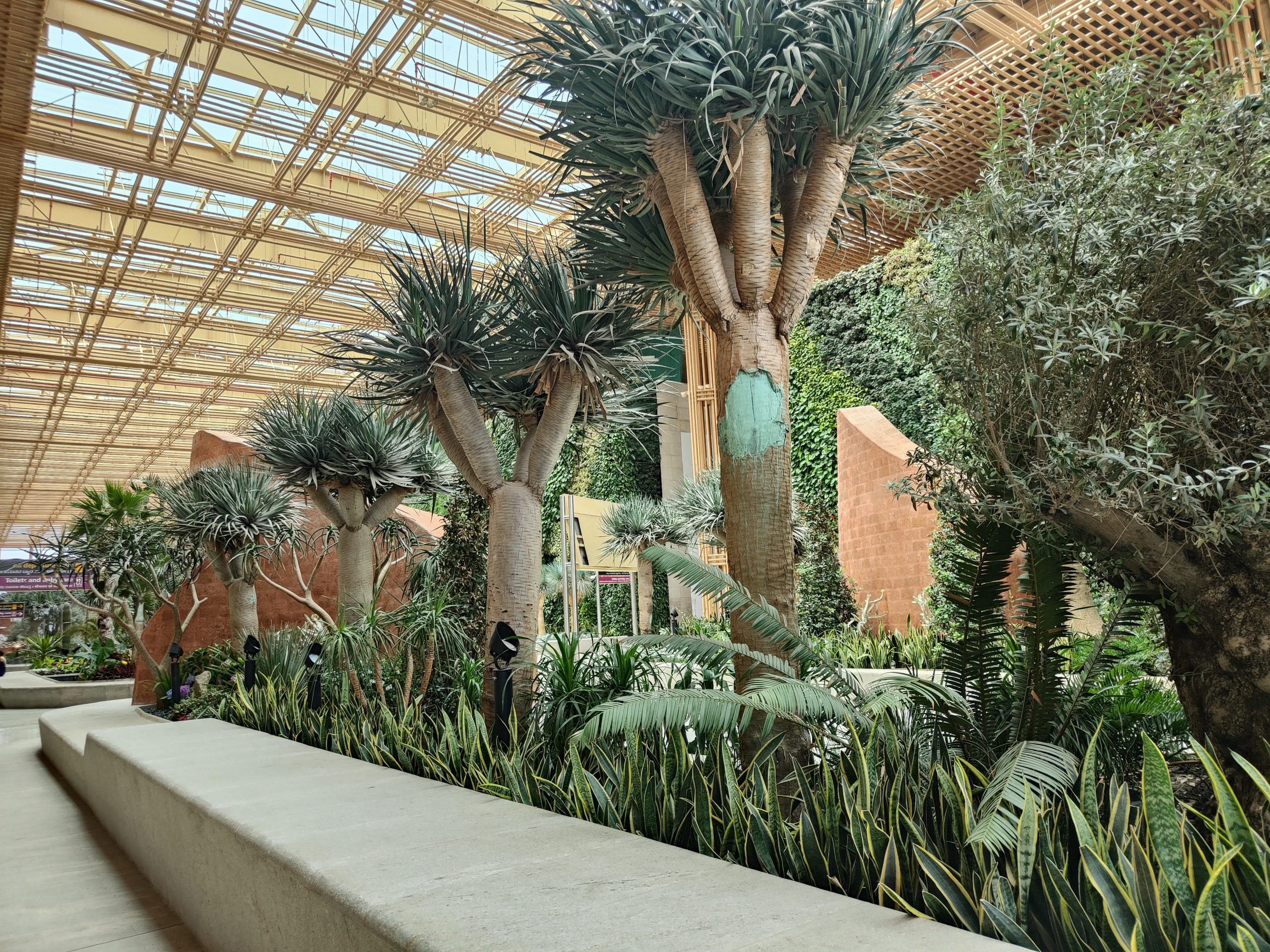

Forestry at T2. CREDIT: Kempegowda International Airport Bengaluru
These plants have been mentioned in Hinduism, Jainism, Buddhism, Judaism, Christianity, Islam and Sikhism. This conservation encourages passengers to walk the life of Rama in 17 agroclimatic zones, with about 150 trees mentioned in his life story of Ramayana, available to see. The forest includes the lives of 24 Tirthankaras of Jain religion, 11 Buddhas and trees of the Bible and Quran. Trees of nations, month of birth trees, medicinal trees and so on are preserved in the forest. The intent is to give space to conserve and bring back rare, endangered and critical plants and make them common again.
Sustainability at the centre
The idea of creating a self-sustaining airport business was at the core of Bangalore International Airport’s planning and strategy, with sustainability being one of the key principles to guide our business and growth.
Terminal 2 perfectly demonstrates BLR’s commitment to sustainability. Built as a tribute to the garden city of Bengaluru, T2 is an assimilation of sustainability and technology, with art and culture. It is inherently designed to elevate the passenger experience.
Designed to achieve sustainability through structural efficiency and economy through modularity, T2 has been recognised as the largest terminal in the world to be pre-certified with a Platinum LEED rating by the USGBC (US Green Building Council).
T2, located on the north-eastern side of Terminal 1, is built with a vision to further transform BLR Airport into a trusted and preferred international transfer hub”
The terminal employs numerous sophisticated sustainable innovations, including extensive solar shading and intelligent building systems that include engineered fire-retardant bamboo, used for the first time in India. The terminal is designed to capture, treat and reuse rainwater from across the airport. The indoor plantings and outdoor gardens are designed to utilise water that is harvested on-site.
urlWe promised ourselves to deliver a benchmark infrastructure to the nation in 2018 and this was successfully delivered on 11 November 2022.
Our intent was to deliver a project that will last for years to come. It is a haven for pollinators as we move towards being chemical-free in next three years. We aim for the use of active, beautiful and clean principles to harvest and recycle for rainwater conservation. We have about 15 million plants in 175 acres of landscape, which comprises more than 4,000 species of the world. Green walls, hanging gardens, green roofs and interior planting beds hold more than 500 species of various climates of world.
Being close to nature and the effort of creating good habitats have led us to a campus of over 300 species of butterflies and moths, 200 species of pollinators and fireflies. These have been missing since 1985, but, due to habitat creation the population in the airport campus has increased. The Blue Mormon and Southern Birdwing are the closest to my heart.
Being water-positive, energy-positive and carbon-neutral by the clever use of plants, helps sequester inorganic to organic usable carbon at a root zone sink below the ground surrounding the root area. The pollutant Carbon Monoxide and Carbon Dioxides are absorbed by plants and turf roots, converted and stored in the soil as organic Carbon.
T2 is an assimilation of sustainability and technology, with art and culture. It is inherently designed to elevate the passenger experience”
T2, located on the north-eastern side of Terminal 1, is built with a vision to further transform BLR Airport into a trusted and preferred international transfer hub. While Terminal 1 and the two parallel runways have the capability of handling up to 45 million passengers per annum, the commissioning of the new terminal is expected to extend the capacity to about 80 – 90 million passengers by 2030.
Connectivity
BLR Airport is working to expand all access roads leading to the airport, alongside investing in improving airside operations. This includes runways, taxiways and aprons.
The upcoming multi-modal transport hub (MMTH), which exists just outside the terminal, can facilitate seamless traffic flow and limit pollution. Besides being a junction for passengers to switch between multiple modes of transport including taxis, sub-urban railways and metro connectivity, it can also serve as a retail and event hub.
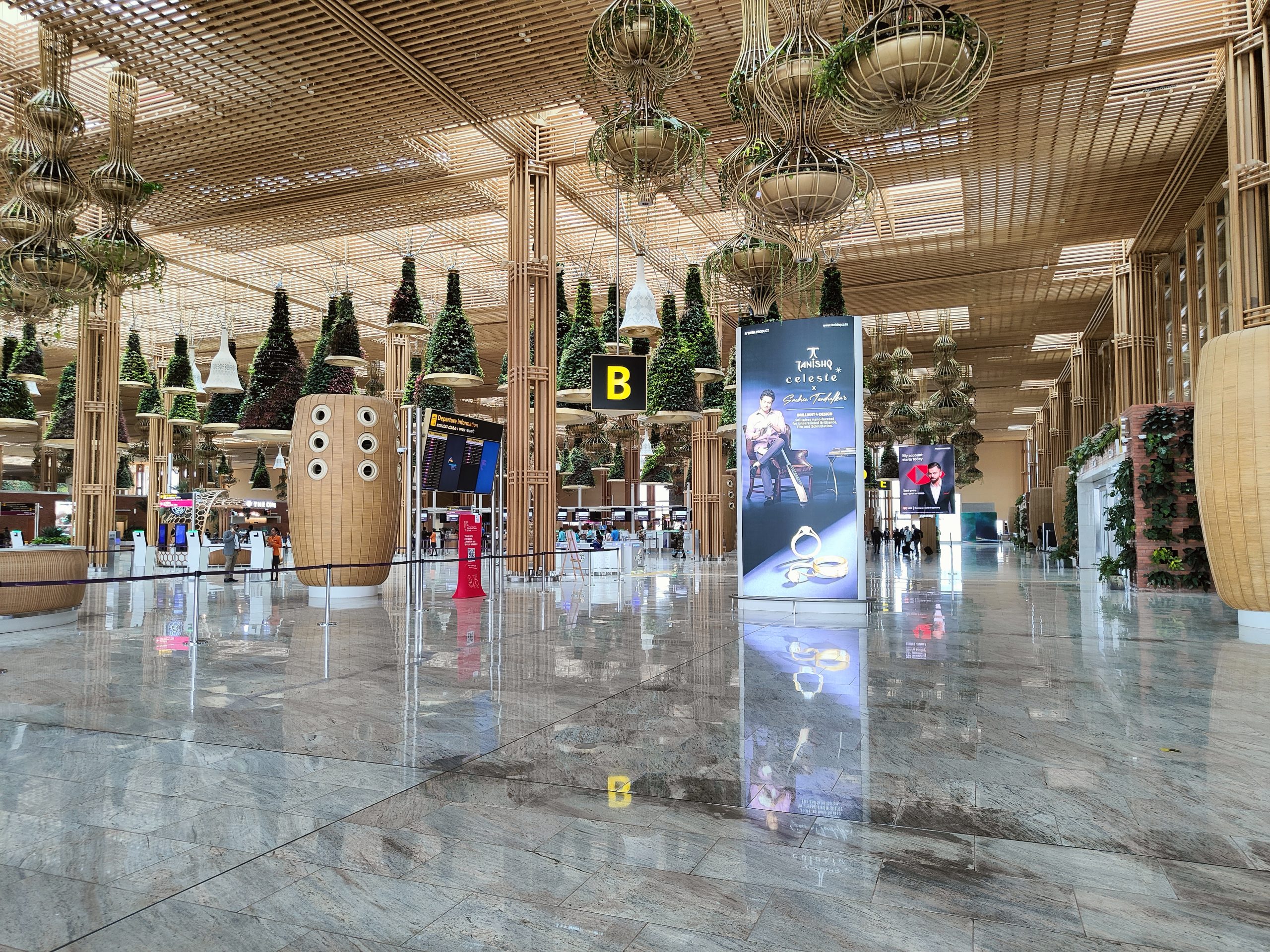

CREDIT: Kempegowda International Airport Bengaluru
T2 is designed for easy transfers which ensure minimum connection times. It is also equipped to handle both international and domestic operations and boasts of a high number of wide body contact stands to accommodate all types of aircraft.
Utilising digital technology
The airport is the first in India to employ Building Information Modelling (BIM) for an end-to-end project delivery of the entirety of T2. This is further helped with the seamless integration of digital facilities management. BLR Airport is also one of the first airports to be built on a software-defined network, effectively automating the ICT network equipment deployment and management with in-built security features.
The essence of T2 lies in its application of innovation and technology to ensure a simplified and effortless passenger experience. From entry into the airport to the boarding of the aircraft, passengers can experience an easy check-in process, faster security check and convenient boarding. Several technological innovations including self-baggage drops and automated tray retrieval systems, have been implemented for an easy passenger journey.
At the core of all its processes, Bangalore International Airport is committed to ensure an experience like never before for its passengers. Despite the crisis of COVID-19, the team at BLR Airport continued to deliver services, with a special focus on punctuality, all while following strict COVID-19 protocols.
BLR Airport was recently ranked second on the prestigious ‘Cirium On-Time Performance’ and was recognised for 84.08% on-time departures. This validated our commitment to providing a world-class service.
From ensuring seamless journeys for our passengers with technological innovations; round-the-clock customer care to implementing environmentally-friendly measures to positively impact passengers and the local community, BLR aims to deliver the best-in-class service, while being a front-runner in sustainability.
Finally, a big thank you must be given to Mr. Hari Marar, MD and CEO, who is a passionate human being and a source of inspiration who exceeds the expectation of the entire management of BIAL.
Terminal 2 commenced operations on 12 September 2023.
About the author – Prasannamurti Desai


Prasannamurti Desai is the Vice President of Head Landscape at Bangalore International Airport (BLR).
Prasannamurti is an experienced landscape horticulture professional with over 24 years of experience.
Starting his career in India, he worked in the fields of real estate (both residential and commercial projects), golf courses, high-end hotels, and airport landscape. His broad experience extends through arid climate, tropical subcontinent and temperate climate across 18 states of India.
His international experience includes Asia and Australia. He has managed and delivered more than 50 million sqm of landscape projects in India. He is a long-standing Member of the Chartered Institute of Horticulture (MCHort), American Society of Landscape Architects (ASLA).
He is currently heading BLR’s Landscape department. He has delivered landscape development on themes around ‘Terminal in the Garden’ and enhanced it to ‘Terminal in Biodiversity Habitat’, for the largest airport infrastructure development of the country.
Issue
Related topics
Airport development, Biodiversity, Passenger experience and seamless travel, Social responsibility, Sustainability, Sustainable development, Terminal operations


















